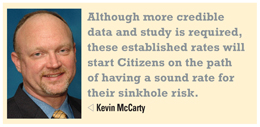 A 45-day regulatory drama that began with Citizens Property Insurance Corp.'s triple-digit sinkhole rate increase proposal on August 3 ended with Florida Insurance Commissioner Kevin McCarty' s eleventh-hour denial on September 19.
A 45-day regulatory drama that began with Citizens Property Insurance Corp.'s triple-digit sinkhole rate increase proposal on August 3 ended with Florida Insurance Commissioner Kevin McCarty' s eleventh-hour denial on September 19.
The prequel for the face-off goes back to the 2011 legislative session.
Although a 2010 Florida law capped the state-run insurer's overall rate increases at 10 percent, the 2011 passage of SB 408 lifted the ceiling specifically on Citizens' sinkhole premium increases as part of the sweeping residential property reforms. That change allowed Citizens to vie for a significant increase in the sinkhole portion of its rate filing to compensate for the loss costs in that coverage.
Recommended For You
Want to continue reading?
Become a Free PropertyCasualty360 Digital Reader
Your access to unlimited PropertyCasualty360 content isn’t changing.
Once you are an ALM digital member, you’ll receive:
- Breaking insurance news and analysis, on-site and via our newsletters and custom alerts
- Weekly Insurance Speak podcast featuring exclusive interviews with industry leaders
- Educational webcasts, white papers, and ebooks from industry thought leaders
- Critical converage of the employee benefits and financial advisory markets on our other ALM sites, BenefitsPRO and ThinkAdvisor
Already have an account? Sign In Now
© Touchpoint Markets, All Rights Reserved. Request academic re-use from www.copyright.com. All other uses, submit a request to [email protected]. For more inforrmation visit Asset & Logo Licensing.







